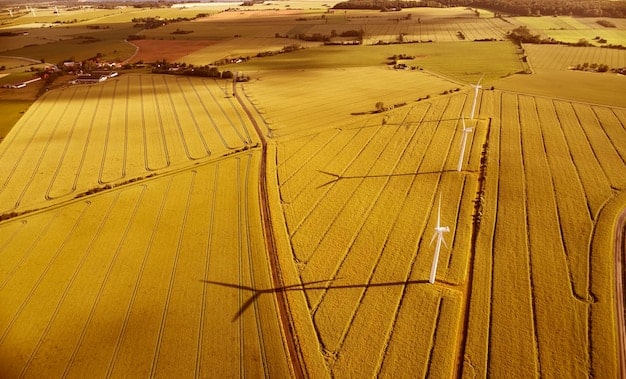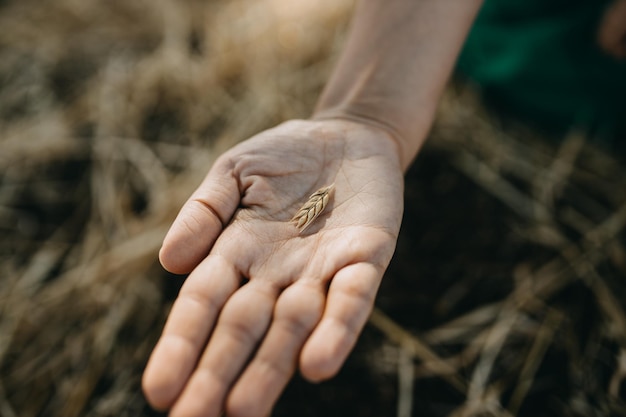Federal Assistance for Farmers: Grants and Loans in 2025

Federal assistance for farmers in 2025 encompasses grants and loans designed to support agricultural businesses, bolstering their operations, promoting sustainability, and ensuring food security across the United States through various government programs.
Navigating the landscape of agricultural finance can be challenging. Understanding the avenues for federal assistance for farmers: grants and loans to support agricultural businesses in 2025 is crucial for sustained growth and stability.
Understanding Federal Assistance for Farmers in 2025
Federal assistance plays a vital role in supporting American farmers. These programs are designed to help agricultural businesses thrive, innovate, and contribute to the nation’s food supply.
In 2025, several grant and loan programs are available to assist farmers in various aspects of their operations. Let’s delve into what these entail.
Types of Federal Assistance Available
The U.S. government offers a range of financial assistance programs tailored to the unique needs of farmers. These include grants, loans, and other forms of support.
- Grants: Typically do not require repayment and are often awarded for specific projects or initiatives, such as implementing sustainable farming practices.
- Loans: Provide capital that must be repaid over time, often with favorable interest rates, helping farmers invest in equipment, land, or infrastructure.
- Disaster Assistance: Designed to help farmers recover from natural disasters, such as droughts, floods, or wildfires.
Understanding these different types of assistance is the first step in determining which programs best fit your farm’s needs and goals.

Key Agencies Providing Assistance
Several federal agencies administer programs aimed at supporting farmers. Knowing which agencies to turn to can streamline the application process.
- Farm Service Agency (FSA): Offers loans, disaster assistance, and conservation programs.
- Natural Resources Conservation Service (NRCS): Provides technical and financial assistance for conservation efforts.
- Rural Development (RD): Supports rural businesses and communities through loans and grants.
Each agency has its own set of programs and eligibility requirements, so it’s essential to familiarize yourself with their offerings. The FSA is often the first point of contact for many farmers seeking assistance.
Federal assistance for farmers in 2025 includes various grants and loans. The Farm Service Agency (FSA), Natural Resources Conservation Service (NRCS), and Rural Development (RD) are key agencies offering this assistance.
FSA Loan Programs for Agricultural Businesses
The Farm Service Agency (FSA) offers a variety of loan programs to help farmers start, expand, or maintain their operations. These loans are particularly beneficial for those who may not qualify for traditional commercial loans.
FSA loans are categorized into two main types: farm ownership loans and farm operating loans. Let’s explore each in detail.
Farm Ownership Loans
Farm ownership loans are designed to help farmers purchase or expand their farms. These loans can be used to acquire land, construct or improve buildings, or make other long-term investments.
There are several types of farm ownership loans available:
- Direct Farm Ownership Loans: Offered directly by the FSA, these loans have maximum loan amounts and repayment terms.
- Guaranteed Farm Ownership Loans: Made by commercial lenders but guaranteed by the FSA, these loans can offer larger loan amounts and more flexible terms.
- Down Payment Loan Program: Specifically for beginning farmers, this program helps with the down payment required to purchase a farm.
Careful consideration of your farm’s long-term goals will help determine which type of farm ownership loan is the best fit.
Farm Operating Loans
Farm operating loans provide farmers with the capital needed to cover operating expenses, such as purchasing livestock, equipment, or supplies. These loans are critical for the day-to-day management of a farm.
Similar to farm ownership loans, operating loans also come in direct and guaranteed forms:
- Direct Farm Operating Loans: These loans can be used for a variety of operating expenses, with repayment terms tailored to the specific needs of the farm.
- Guaranteed Farm Operating Loans: These loans are made by commercial lenders and guaranteed by the FSA, offering larger loan amounts and potentially more favorable terms.
Farmers should assess their short-term financial needs carefully to determine the appropriate amount and type of operating loan to pursue.
FSA loan programs offer farm ownership and operating loans, available in direct and guaranteed forms. These programs cater to different financial needs, from purchasing land to covering daily expenses.
Grant Opportunities for Sustainable Farming Practices
Many farmers are increasingly interested in adopting sustainable farming practices to improve soil health, conserve water, and reduce their environmental impact. Several grant programs support these efforts.
These grants often focus on conservation, innovation, and research. Let’s explore some of the key opportunities.
Environmental Quality Incentives Program (EQIP)
The Environmental Quality Incentives Program (EQIP) provides financial and technical assistance to farmers who implement conservation practices on their land. This program is administered by the NRCS.
EQIP supports a wide range of conservation practices, including:
- Cover Cropping: Planting crops to protect and improve the soil.
- No-Till Farming: Reducing soil disturbance to minimize erosion and improve water infiltration.
- Nutrient Management: Optimizing fertilizer use to reduce nutrient runoff.
Farmers who participate in EQIP can receive payments to help offset the costs of implementing these practices, making sustainable farming more accessible and affordable.

Conservation Stewardship Program (CSP)
The Conservation Stewardship Program (CSP) rewards farmers who are already implementing conservation practices and encourages them to adopt additional measures to enhance their environmental stewardship. This program is also administered by the NRCS.
CSP provides payments for maintaining existing conservation practices and implementing new ones, such as:
- Improving Grazing Management: Implementing rotational grazing systems to improve pasture health.
- Enhancing Wildlife Habitat: Creating or restoring habitats for native species.
CSP is designed to recognize and support farmers who are committed to continuous improvement in their conservation efforts.
Grants like EQIP and CSP provide financial incentives for farmers adopting sustainable practices, like cover cropping and wildlife habitat enhancement. These programs, administered by the NRCS, promote environmental stewardship.
Navigating the Application Process for Federal Aid
Applying for federal assistance can seem daunting, but with careful preparation and attention to detail, farmers can increase their chances of success. Understanding the application process and eligibility requirements is essential.
Each program has its own specific requirements, but there are some general steps that all applicants should follow.
Researching Available Programs
The first step is to thoroughly research the available programs and identify those that align with your farm’s needs and goals. The USDA website is a valuable resource for finding information on federal assistance programs.
Consider the following factors when researching programs:
- Eligibility Requirements: Ensure that you meet the eligibility criteria for the program, such as farm size, income, or specific farming practices.
- Funding Priorities: Understand the program’s funding priorities, such as supporting beginning farmers or promoting specific conservation practices.
- Application Deadlines: Be aware of the application deadlines and plan accordingly to ensure that you submit your application on time.
Take the time to read program guidelines carefully to gain a clear understanding of the requirements and expectations.
Preparing a Strong Application
A well-prepared application is critical for securing federal assistance. Your application should clearly articulate your farm’s needs, goals, and how the requested assistance will help you achieve them.
Include the following information in your application:
- Farm Description: Provide a detailed description of your farm, including its size, location, and farming practices.
- Financial Information: Include financial statements, such as balance sheets and income statements, to demonstrate your financial need.
- Project Plan: If you are applying for a grant or loan to support a specific project, provide a detailed project plan outlining the goals, activities, and expected outcomes.
Seek assistance from agricultural extension agents or consultants if needed to ensure that your application is complete and accurate.
Successfully applying for federal aid involves researching programs, understanding eligibility, and preparing a strong application. The USDA website provides resources, and seeking expert advice can also be beneficial.
Planning for the Future: Maximizing Federal Support
Securing federal assistance is just one step in ensuring the long-term success of your farm. It’s important to integrate federal support into a broader financial and strategic plan.
Effective planning involves not only accessing available resources but also using them wisely. Here’s what to consider.
Developing a Comprehensive Business Plan
Every farm should have a comprehensive business plan that outlines its goals, strategies, and financial projections. This plan should integrate any federal assistance received and demonstrate how it will contribute to the farm’s overall success.
Include the following elements in your business plan:
- Executive Summary: A brief overview of your farm and its goals.
- Market Analysis: An assessment of your target market and competitive landscape.
- Financial Projections: Projected income statements, balance sheets, and cash flow statements.
Regularly review and update your business plan to reflect changes in your farm’s operations, market conditions, or financial situation.
Building Relationships with Agencies
Building strong relationships with the federal agencies that administer assistance programs can be invaluable. Attend workshops, seminars, and other events to network with agency staff and learn about new programs or initiatives.
Consider the following strategies:
- Attend Informational Sessions: Participate in sessions organized by the FSA, NRCS, or RD to stay informed about program updates.
- Seek Technical Assistance: Take advantage of technical assistance offered by these agencies to improve your farming practices and conservation efforts.
- Communicate Regularly: Maintain regular communication with agency staff to stay abreast of opportunities and address any questions or concerns.
These relationships can provide ongoing support and guidance as you navigate the landscape of federal assistance.
Planning for the future involves developing a comprehensive business plan and building relationships with federal agencies. Regular updates and communication can maximize the benefits of federal support for your farm.
Case Studies: Success Stories of Farmers Utilizing Federal Aid
Real-world examples can illustrate the impact of federal assistance on agricultural businesses. Reviewing case studies of farmers who successfully utilized grants and loans can offer valuable insights and inspiration.
These stories highlight the diverse ways in which federal aid can be leveraged to achieve various farming goals.
Case Study 1: Implementing Conservation Practices
A small family farm in Iowa used an EQIP grant to implement no-till farming practices and plant cover crops on their land. This reduced soil erosion, improved water quality, and increased crop yields. The farm also received technical assistance from the NRCS, which helped them optimize their conservation efforts.
Case Study 2: Expanding a Farm Operation
A beginning farmer in California obtained an FSA farm ownership loan to purchase additional land and expand their fruit and vegetable operation. This allowed them to increase their production capacity and enter new markets. The farmer also received mentorship from experienced farmers through an FSA program, which helped them navigate the challenges of starting a new business.
These case studies demonstrate the tangible benefits of federal assistance, from improving environmental sustainability to fostering economic growth.
| Key Point | Brief Description |
|---|---|
| 🌱 FSA Loans | Offers farm ownership and operating loans to help farmers get started or expand. |
| 🌍 EQIP & CSP | Provides funds for sustainable practices like cover cropping and habitat enhancement. |
| 📝 Application Process | Involves research, eligibility checks, and detailed application preparation. |
| 📈 Business Planning | Integrate federal support into broader business plans for long-term farm success. |
Frequently Asked Questions
▼
The FSA offers farm ownership loans and farm operating loans. Farm ownership loans help purchase or improve farms, while operating loans cover expenses like livestock or supplies.
▼
EQIP is a program providing financial assistance to farmers implementing conservation practices. It supports environmental stewardship, reduces soil erosion, and improves water quality.
▼
Farmers can improve their applications by researching programs thoroughly, ensuring they meet eligibility, and providing detailed farm and project plans. Seeking expert advice can also help.
▼
CSP rewards farmers already practicing conservation and encourages further improvements. Payments are provided for maintaining and enhancing environmental stewardship on their farms.
▼
Business planning is crucial as it integrates federal support into your farm’s overall strategy. A comprehensive plan demonstrates responsible financial management and farm goals to lenders.
Conclusion
Understanding and utilizing federal assistance for farmers: grants and loans to support agricultural businesses in 2025 can significantly bolster your agricultural operations. By exploring programs like FSA loans, EQIP, and CSP, and effectively navigating the application process, farmers can access vital resources to grow sustainably and securely into the future.





